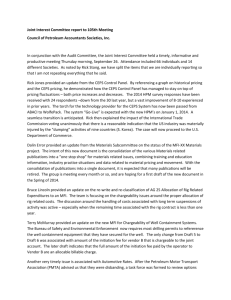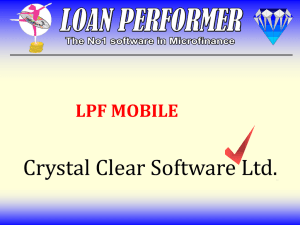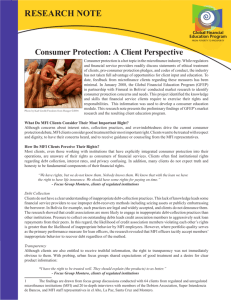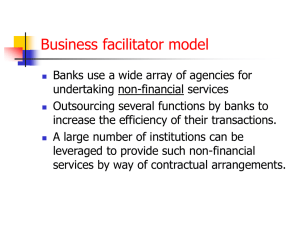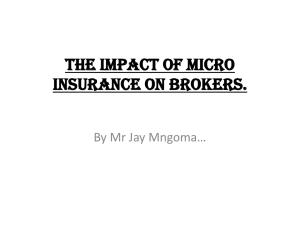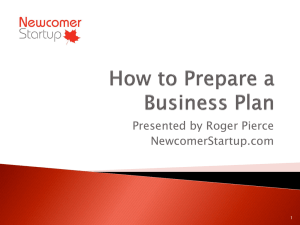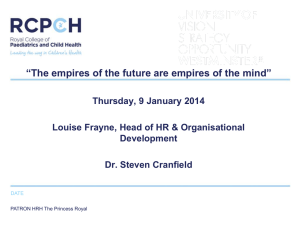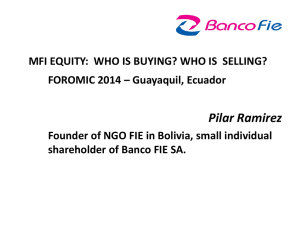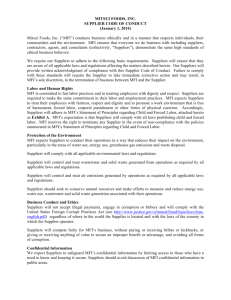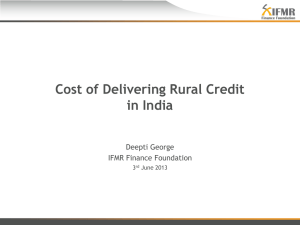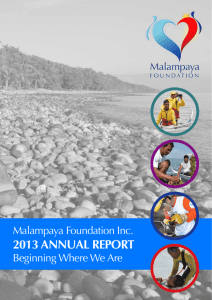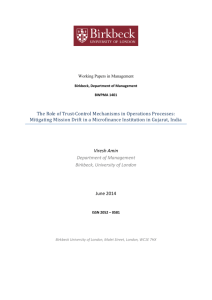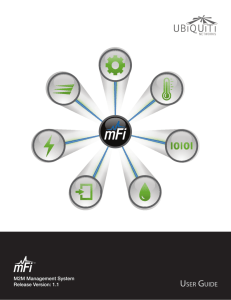Health_Microinsurance_N4A_FINAL
advertisement
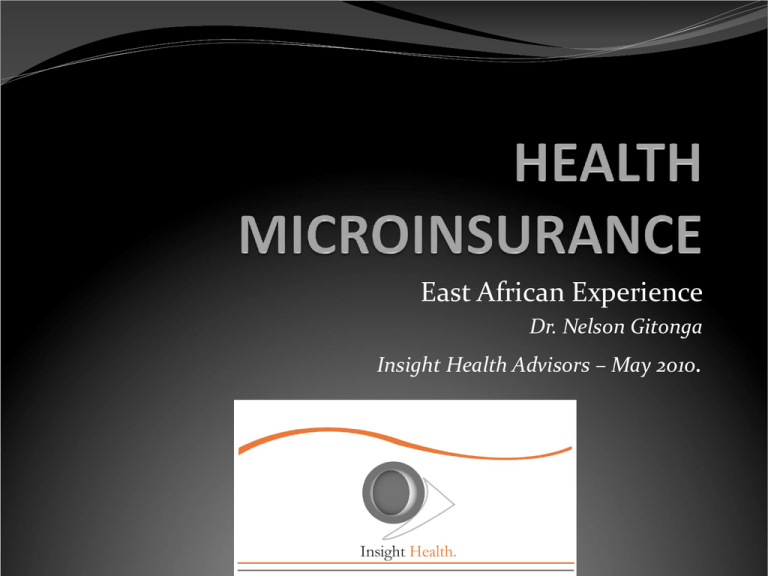
East African Experience Dr. Nelson Gitonga Insight Health Advisors – May 2010. WHY MICRO HEALTH INSURANCE? There is a viscous cycle between health status and poverty Lack of resources is one of the biggest barrier to accessing health services for the poor and low income earners In Kenya 38% of the ill who who did not seek care cited lack of money as key barrier (Kenya Household Health Expenditure Survey 2007) Out-of-pocket spending on health only worsens poverty WHO estimates 125 million households globally spend over 50% of annual income on health Catastrophic healthcare expenses drives about 25 million households into poverty each year Poor households identify Illness/Injury, Death of family member as the most common causes of decline in wellbeing (Narayan et al 1999) Insight Health Advisors WHAT IS MICRO HEALTH INSURANCE? Definition Low cost voluntary private insurance products and services targeted at the poor and low income earners as a means of protecting them from vulnerability arising from risk events Insight Health Advisors WHAT DO WE KNOW ABOUT MICRO HEALTH INSURANCE? Some basic facts Health insurance is one of the many products offered by micro- insurance The low income earners participating in micro-insurance usually come from largest economic sectors in East Africa – informal and agriculture Most common model for micro-insurance is a Partnership Model The risk carrier (insurer) partners with a distribution & financing channel (MFI’s and other community & agricultural organisations) and a network of low cost health providers (often public, FBO and small private providers) Donors subsidize premiums/contributions in some cases to facilitate affordability and fast uptake of the products Insight Health Advisors HOW CAN MICRO HEALTH INSURANCE HELP? Micro-insurance can play a key part in poverty alleviation, income protection, and health status: Reaching low income earners –frequently left out by conventional private health insurance and public pay-roll based health insurance schemes Acting as the primer for future expansion of public/social health insurance and offer useful lessons for planning universal coverage Offering more sustainable health insurance than community insurance since its risk is managed professionally and can be bundled with other insurance and financial services When combined with other micro-insurance products and microfinance services, its an essential part of providing broad vulnerability protection to the poor and low income earners. Insight Health Advisors HOW TO DESIGN A MICRO HEALTH INSURANCE PLAN Step 1: Strategy, Goals, Model Step 5: Product Administration KEY STEPS Step 4: Product Distribution Insight Health Advisors Step 2: Market/Target Research Step 3: Product Development WHAT ARE KEY PROCESSES TO IMPLEMENT MICRO HEALTH INSURANCE? Marketing & Distribution of products and services by agent organisation (MFI, farmers organisation, community group etc) Recruitment of members and payment of contributions (If MFI is involved they may finance the contributions). Contributions maybe annual or monthly. Accessing services from selected panel of healthcare providers (access control through lists, ID, referrals, photo or biometric cards) Interface between provider and insurer through managed care principles. Processing of claims and payment (Fee for service, fixed reimbursements and capitation). Client relations and insurance cover renewal process. Financial and business management of scheme Insight Health Advisors CHALLENGES WITH MICRO-INSURANCE Without subsidies will not be affordable for the very low income earners and absolute poor. Presents high financial risk for insurer (e.g. high transaction and admin costs, low retention, fraud, financial and social volatility and of target groups) Problems associated with adverse selection and moral hazard since it is voluntary insurance Difficult to build sufficiently large risk pool for sustainability Lack of technical ICT and management skills to manage the schemes Shortage of health workers and poor health infrastructure Weak or restrictive regulatory framework Lack of understanding of insurance concept (risk pooling) among targeted groups Insight Health Advisors EXAMPLES FROM EAST AFRICA Existing micro-insurance schemes Kenya: CIC Insurance with various MFI’s (some initial donor support). British American Insurance with KTDA (Kenya tea development authority) (some initial donor support). UAP Insurance with Equity bank. Various MFI initiated schemes -Faulu Kenya Uganda: Microcare Insurance (Closed down?) (some initial donor support) NB: In all the above cases thorough and systematic reviews and case studies are needed to distil the valuable lessons learned Insight Health Advisors EXAMPLES OF MICRO HEALTH INSURANCE CIC/MFI’s Microcare/CBO’s UAP/MFI Inception date Model 2001 Partnership of Insurer btwn MFI’s (Faulu, KADET, KWFT, KREP) and co-op societies. 2000 Insurer/HMO working directly with CBO’s and MFI’s. Mid 2008 Partnership of insurer with Equity Bank (Commercial bank and MFI) Target Group Geographical Coverage Clients and members of participating organisations in rural and urban areas Formal and informal sector /community organisations in urban and rural areas. MFI members. Bank Clients across the country. Initial pilot selected urban areas. Benefits IP cover including HIV/AIDS and chronic conditions. Also sold public IP insurance cover – NHIF. Comprehensive IP and OP cover, each unique to the group insured. Includes HIV/AIDS & health promotion. OP and IP cover including HIV/AIDS, chronic conditions & maternity. Fixed reimbursements and capitation used. Outpatient (OP) Inpatient (IP) Insight Health Advisors EXAMPLES OF MICRO HEALTH INSURANCE CIC/MFI’s Microcare/CBO’s UAP/MFI Membership & Characteristics 13,000 members (2008 - all microinsurance products - 260,000) 85,000 members (2007) 2,000 (2009) Average Premium /Contribution $80 p.a. (for a $ 30 to $ 300 p.a. For IP family of 5, shared and OP cover. IP cover limit $ 7,000 p.a. (20072008). NHIF option $ 26 p.a. per family. From $ 90 to $ 280 per person p.a. for IP and OP cover ranging from $ 1,000 to $ 13,000 p.a. (2008) Comments Claims and admin costs higher than anticipated, hence financial loss. Challenge of MFI’s marketing insurance. Unique bancassurance model. Bank finances premiums. Uptake good but slower than expected. Profitable in 2nd Year. Insight Health Advisors Microcare collapsed in 2008. Possible causes: Low premiums compared to risks, financial & risk mngt, adverse selection, member & provider fraud, rapid growth. Thank you! Please contact me through the Network for Africa if you have more Questions at www.network4africa.com Horton Court| Lenana Road 3rd Flr| Suite G| P. 0 Box 29775 00202 | Nairobi| ngrgachoka@gmail.com| +254 202 504 628
